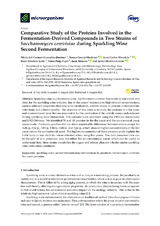Comparative Study of the Proteins Involved in the Fermentation-Derived Compounds in Two Strains of Saccharomyces cerevisiae during Sparkling Wine Second Fermentation
Autor
González-Jiménez, María del Carmen
García-Martínez, Teresa
Mauricio, Juan C.
Sánchez-León, Irene
Puig Pujol, Anna
Moreno, Juan
Moreno-García, Jaime
Editor
MDPIFecha
2020Materia
Sparkling wineSecond fermentation
Fermentation by-products
Saccharomyces cerevisiae flor yeast
Proteins
METS:
Mostrar el registro METSPREMIS:
Mostrar el registro PREMISMetadatos
Mostrar el registro completo del ítemResumen
Sparkling wine is a distinctive wine. Saccharomyces cerevisiae flor yeasts is innovative and ideal for the sparkling wine industry due to the yeasts’ resistance to high ethanol concentrations, surface adhesion properties that ease wine clarification, and the ability to provide a characteristic volatilome and odorant profile. The objective of this work is to study the proteins in a flor yeast and a conventional yeast that are responsible for the production of the volatile compounds released during sparkling wine elaboration. The proteins were identified using the OFFGEL fractionator and LTQ Orbitrap. We identified 50 and 43 proteins in the flor yeast and the conventional yeast, respectively. Proteomic profiles did not show remarkable differences between strains except for Adh1p, Fba1p, Tdh1p, Tdh2p, Tdh3p, and Pgk1p, which showed higher concentrations in the flor yeast versus the conventional yeast. The higher concentration of these proteins could explain the fuller body in less alcoholic wines obtained when using flor yeasts. The data presented here can be thought of as a proteomic map for either flor or conventional yeasts which can be useful to understand how these strains metabolize the sugars and release pleasant volatiles under sparkling wine elaboration conditions.

